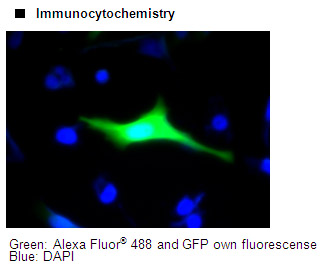Anti-GFP (Green Fluorescent Protein) mAb-Alexa Fluor 488
| Code | Size | Price |
|---|
| MBL-D153-A48 | 50 ul | £268.00 |
Quantity:
Prices exclude any Taxes / VAT
Overview
Host Type: Rat
Antibody Isotype: IgG2a κ
Antibody Clonality: Monoclonal
Antibody Clone: RQ2
Regulatory Status: RUO
Application: Immunocytochemistry (ICC)
Shipping:
4°C
Storage:
4°C
Images
Documents
Further Information
Applications:
ICC - 2-5 ug/mL *This antibody is not suitable for alcohol fixation such as
ethanol or methanol.
Background:
Since the detection of intracellular
Aequorea Victria Green Fluorescent Protein (GFP) requires
only irradiation by UV or blue light, it provides an excellent
means for monitoring gene expression and protein
localization in living cells. Monoclonal anti-GFP antibody
can detect GFP fusion protein on Immunocytochemistry.
Concentration:
1 mg/mL
Formulation:
50 ug IgG in 50 ul volume of PBS containing 1% BSA and 0.09% NaN3.*Azide may react with copper or lead in plumbing system to formexplosive metal azides. Therefore, always flush plenty of waterwhen disposing materials containing azide into drain.
Immunogen Translated:
GFP was affinity-purified anti-GFP by using a mouse from 293T cells expressing GFP
Reactivity:
This antibody reacts with GFP fusion
protein on Immunocytochemistry. It reacts with EBFP,
ECFP, EGFP, Venus and Sapphire.
Shelf Life:
1 year
Source:
This antibody was purified from hybridoma (clone RQ2) supernatant using protein G agarose. This hybridoma was established by fusion of mouse myeloma cell PAI with Wistar rat lymph node immunized with GFP purified from GFP expressed 293T cells by affinity chromatographic technique using mouse anti-GFP
Target:
GFP
References
1) Sato, Y., et al., J. Biol. Chem. 284, 11873-11881 (2009)
2) Sakurai, T., et al., J. Cell Biol. 183, 339-352 (2008)
3) Kato, A., et al., J. Virol. 82, 6172-6189 (2008)
4) Dragone, L. L., et al. PNAS. 103, 18202-18207 (2006)
5) Darzacq, X., et al. J. Cell Biol. 173, 207-218 (2006)
6) Hayakawa, T., et al. Plant Cell Physiol. 47, 891-904 (2006)
7) Obuse, C., et al. Nat. Cell Biol. 6, 1135-1141 (2004)
Clone RQ2 is used in these references.



